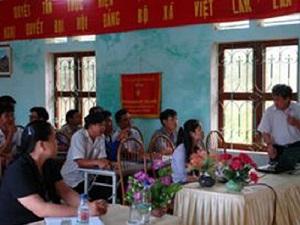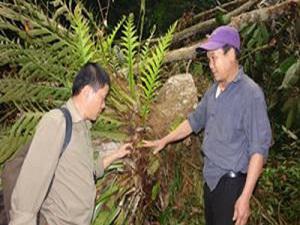Cu Luu Dam
This project aims to develop a conservation strategy for rare and endangered medicinal plants to preserve biodiversity, enhance sustainable use and improve livelihood of ethnic minority communities in Vietnam.

Dr. Luu Dam Cu give a lecture in workshop.
In Vietnam, there are more than 90% of medicinal plants growing wildly and distributing mainly in the forestry ecosystems of the mountainous provinces. These plants not only play an important role to traditional culture and economic income for ethnic minorities living in the mountainous areas but also are used widely for traditional pharmacies in Vietnam. However, the overexploitation and poor public awareness on biodiversity conservation caused a serious erosion of genetic resource of medicinal species; unfortunately many of them became rare and endangered, such as Anoectochilus roxburghii, Paris polyphylla, Calocedrus macrolepis, Nervilia fordii, etc.

Survey medicinal plants in nature.
Additionally, for quite a long time, Vietnamese ethnic minority communities have highly experienced how to use native landraces resources for disease treatment, health care and income generation. Tay and Nung are considered as two of the most potential minority communities in collecting regularly natural medicinal plants in the forest and preserving associated cultural diversity. But this diversity tends to be preserved only at community level and eroding by the time. This project, therefore, will play an important role in providing ideal findings for setting up priorities for the conservation strategy and sustainable use of medicinal plants in ethnic minority communities. As a result, while conserving the genetic resource of the target plant species, associated traditional knowledge and culture will be preserved, public awareness on biodiversity conservation will be strengthened and poverty alleviation will be improved.
The project will be carried out in Viet Vinh commune (Bac Quang district), Viet Lam and Cao Bo communes (Vi Xuyen district), Ha Giang province where Tay and Nung people are highly populated. In 2008, we plan to conduct surveys on the fields and households and to organize a stakeholder consultative workshop with participation of local people including collectors, users, traders, herbalists, and local and provincial authorities. Another major part of the project will be investigated through a community-participated workshop. This is one of the most important steps to develop an effective conservative strategy by gathering the voice of local stakeholders. As a part of the strategy, an applicable conservation model will be proposed. This useful information will be used to develop follow-up proposals for conserving and using substantially genetic resource of traditional medicinal plants as well as traditional knowledge system.